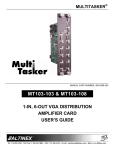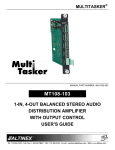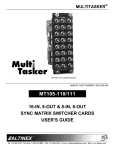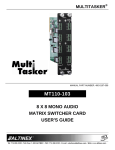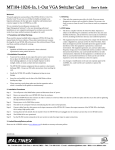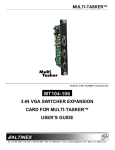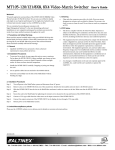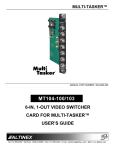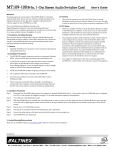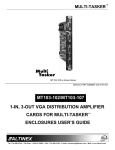Download Altinex Multi Tasker MT103-122 User`s guide
Transcript
MT103MT103-102/ 102/1-In, 33-Out VGAVGA-Type DA DA Card User’s Guide Welcome! 1.3 Cleaning We greatly appreciate your purchase of the MT103-102 1-In, 3-Out VGA-Type Distribution Amplifier Card. We are sure you will find it reliable and simple to use. Superior performance for the right price, backed by solid technical and customer support is what ALTINEX has to offer. • We are committed to providing our customers with Signal Management Solutions® to the most demanding audiovisual installations at very competitive pricing and we welcome you to join the ranks of our many satisfied customers throughout the world. 1.4 FCC Notice • This device complies with Part 15 of the FCC Rules. Operation is subject to the following two conditions: (1) This device may not cause harmful interference, and (2) this device must accept any interference received, including interference that may cause undesired operation. • This equipment has been tested and found to comply with the limits for a Class A digital device, pursuant to Part 15 of the FCC Rules. These limits are designed to provide reasonable protection against harmful interference when the equipment is operated in a commercial environment. This equipment generates, uses, and can radiate radio frequency energy and, if not installed and used in accordance with the instructions found herein, may cause harmful interference to radio communications. Operation of this equipment in a residential area is likely to cause harmful interference in which case the user will be required to correct the interference at his own expense. • Any changes or modifications to the unit not expressly approved by ALTINEX, Inc. could void the user’s authority to operate the equipment. 1. Precautions and Safety Warnings Please read this manual carefully before using your MT103-102 and keep it handy for future reference. These safety instructions are to ensure the long life of your MT103-102 and to prevent fire and shock hazards. Please read them carefully and heed all warnings. 1.1 General • Qualified ALTINEX service personnel or its authorized representatives must perform all service. 1.2 Installation Precautions • Handle the MT103-102 carefully. Dropping or jarring can damage the card. • The MT103-102 contains components that are sensitive to electrostatic discharge (ESD). Always use ESD safety precautions when touching the card. • To prevent fire or shock, do not expose this unit to water or moisture. Do not place the MT103-102 in direct sunlight, near heaters, or heat-radiating appliances, or near any liquid. Exposure to direct sunlight, smoke, or steam can harm internal components. • Do not pull any cables that are attached to the MT103-102. Clean only the connector area with a dry cloth. Never use strong detergents or solvents such as alcohol or thinner. Do not use a wet cloth or water to clean the card. Do not clean or touch any component or PCB. 2. Installation Procedures Step 1. Turn off power to the MultiTasker® system and disconnect from AC power. Step 2. Remove a slot cover (MT200-101) from one of the unused slots. Identify the slot number and note that it is for RS-232 control. Step 3. Slide the MT103-102 into the MultiTasker enclosure in order to connect to the bus. Make sure that the card fits into place and then secure the card by tightening the retainer screws located on the top and bottom of the card. Step 4. Restore power to the MultiTasker system. Step 5. The LED on the card panel will turn red indicating that the card is in full operation. A green LED indicates that an input signal is present. Step 6. Connect a VGA cable from the video source to the input connector of the MT103-102. Connect the output connectors of the MT103-102 to the display devices through VGA cables. Step 7. The MT103-102 is now operational. 3. Limited Warranty/Return policies Please see the ALTINEX website at www.altinex.comfor details on warranty and return policies. 400-0107-006 1 MT103 MT103103-102 User’s Guide 4. Technical Specifications Specifications are subject to change. See www.altinex.com for up-to-date information. Features/Description MT103-102 Electrical Inputs Input Connector Input Video Signal 15-pin HD F (1) Analog Outputs Output Connectors Output to Internal Sync-on-Green 15-pin HD F (3) Impedance 10-pin IDC (1) RGB, RGsB, RGBS, RGBHV, YPbPr Video Resolutions VGA through QXGA, 480p through 1080i Expansion Cards MT103-104 and MT103-109 15-pin HD M to 5-BNC F MS8106CA Enclosure Slots Required TTL (+/-) Impedance 10 kohms Impedance TTL (+/-) Impedance 22 ohms Shipping Weight 1.0 lb (0.5 kg) +6V 300 mA (1.8 W) -6V 250 mA (1.5 W) Connector Panel Black Total Power T° Operating 10°C-40°C T° Storage 0°C to 50°C Table 3. MT103-102 Electrical 90% non-condensing 58,000 hrs Table 2. MT103-102 Mechanical 400-0107-006 (from enclosure) One 0.4 lb (0.2 kg) MTBF (calc.) 0 dB +/- 0.5 dB Horizontal, Vertical Power Consumption MT103-102 Weight Humidity 75 ohms Output Sync Signal Table 1. MT103-102 General Mechanical 75 ohms Horizontal, Vertical Gain MS8102CA -0.3 to 1.5 Vp-p max Output Video Signal Optional Accessories 15-pin HD M to 5-BNC M 1.5 Vp-p max. Input Sync Signal Compatibility Signal Types MT103-102 2 3.3 W max. MT103 MT103103-102 User’s Guide 5. About Your MT103-102 The MT103-102 1-In, 3-Out VGA DA card is designed to connect a single computer video source to three monitors or projectors. The MT103-102 supports resolutions from VGA through QXGA. Each output is buffered and does not require a termination if unused. Female 15-pin HD (VGA-type) connectors are provided for each input and output. If used together with 15-pin HD to 5 BNC adapter cables available from ALTINEX, the VGA DA series can pass RGBHV format video signals where 5 BNC cable installations are already in place. For maximum power and flexibility, the MT103-102 offers the greatest bandwidth performance, and the ability to turn each output on or off through RS-232 or front panel control. On/Off control is augmented by screen blanking which eliminates annoying signal-loss messages by maintaining the sync signal on all attached projectors and monitors. The MT103-102 can be connected to an MT103-104 or MT103-109 VGA DA expansion card in order to provide 6 additional VGA outputs. For more information on expansion, see the MT103-104 and MT103-109 cards. 400-0107-006 3 MT103 MT103103-102 User’s Guide 6. Application Diagrams Diagram 1: Typical Setup 400-0107-006 4 MT103 MT103103-102 User’s Guide Diagram 2: Internal View EXPANSION SIGNAL DETECT POWER OUT 1 15-PIN HD F OUT 2 15-PIN HD F INPUT 15-PIN HD F PNP MEMORY OUT 3 15-PIN HD F MT103-102 VGA-QXGA 400-0107-006 5 MT103 MT103103-102 User’s Guide 7. Operation 7.2 Description of Commands 7.1 RS-232 Control Each command consists of three parts: Function, Card ID, and Unit ID. The MT103-102 has many advanced remote-control capabilities accessible through standard RS-232 communication using a computer, control system, or any device capable of RS-232 communication. Example: [VERC3U2] 7.1.1 RS-232 Interface VER = Function C3 = Card ID or Group ID U2 = Unit ID (optional for Unit ID 0) [ Function , Card ID , Unit ID ] The control commands for the MT106-103 are in a simple ASCII character format. 1. Square brackets "[ ]" are part of the command. For Function, see a detailed explanation under each description. 2. Use uppercase letters for all commands. The card ID is a unique identifier. It is equal to the enclosure slot number, or it may be an assigned value. As the slot number, the value can range from 1-4 up to 1-20 depending on the enclosure. If the value is assigned, the ID may be a maximum of 99. Card ID 0 (C0) is used for the controller and cannot be reassigned. 3. Spaces are NOT legal characters. The cards in a MultiTasker are capable of performing various functions, as well as providing feedback to the user or control system. Commands instruct a card to perform specific actions or request information from the card. Some commands do both simultaneously. The group ID is a number representing a group of cards defined with the [WR] command. When using the group ID, all cards in the group perform the given instruction. A command that instructs the card only to perform an action will generate feedback of "[ ]". The open bracket immediately followed by a closed bracket indicates the card received a valid command. If the command requested information from the card, the feedback generated by the card is the acknowledgement of having received a valid command. Invalid commands generate feedback that includes "ERR" plus an error code. Example 1: [ERR001] Example 2: [ERRC04] Changing the position of a card significantly affects the commands recorded on software definitions or third-party control systems. Example: [VERC3]: Error number Card error C4 Commands ending in "S" will be saved into memory. Commands not ending in "S" are executed, but not restored at reset or powered-up. For IDs other than U0 or all MultiTaskers. [VERC3]: Equivalent to [VERC3U0] for U0. The RS-232 commands in this section are organized into the following 5 categories: Card IDs: Basic Commands In this manual, cards are referenced by their card ID; typically equivalent to the slot number: Feedback Control Card Control C1, C2, C3, C4 ... C99 Card IDs Group IDs: Groups Groups are referenced by their group ID: See the Summary of Commands (Section 7.3) for one-line descriptions of each command. G1, G2, G3 ... G8 Unit IDs: Units are referenced by their unit ID: U0, U1, U2 ... U20 Examples for each command in the following sections do not include the unit ID. Commands sent to a MultiTasker without a unit ID are executed by all MultiTaskers connected to the RS-232 bus. It is only necessary to include the unit ID when there is more than one MultiTasker connected to the bus and the command is intended for cards in that MultiTasker only. Executed by all MultiTaskers on the RS-232 bus. [VERC3U1]: Executed by MultiTasker unit ID U1 only. 400-0107-006 [VERC3Ui]: Command Organization 7.1.2 Conventions Used in this Manual [VERC3]: For U0 or all MultiTaskers on the bus. 6 MT103 MT103103-102 User’s Guide 5. [TEST] Basic Commands The basic commands are used to provide general information about the card. These commands are most useful during the initial stages of setting up and operating the card. This command performs a series of tests on the internal memory and displays a pass message if successful. Otherwise, failures are indicated. 1. [VER] Otherwise, failures will be indicated. MEMORY IS GOOD This command displays the software version and model number for a card. Command Format: [TESTCn] Cn Command Format: [VERCn] Cn = Card ID (n = slot # from 1 to max slots) Example: = Card ID (n = slot # from 1 to max slots) In order to test the internal memory of C4, send [TESTC4]. Example: 6. [HELP] An MT103-102 card is in slot 4. Send [VERC4], and receive feedback similar to the following: This command displays information available for the card functions. [MT103-102 690-0125-013 C04] Command Format: [HELPCn] MT103-102 = the card model Cn 690-0125-013 = the software version Example: Display the RS-232 commands for the MT103-102 C4 by sending [HELPC4]. The commands and a brief description will be displayed. 2. [C] This command displays the status of the card. Feedback Control Command Format: [Cn] Cn = Card ID (n = # from 1 to max slots) The next commands are a function of both the card and the front panel and allow flexibility over when and how card information is displayed. = Card ID (n = # from 1 to max slots) Example: 7. [FBD] Send [C4] to receive the card status: This command turns feedback delay on or off. It is necessary when installing some newer cards in older systems. If the system does not receive all of the feedback from the card, the card may be communicating too fast. This command will slow down the card's communication rate. ON: 1,2,3 C04 ON: 1,2,3 = Outputs 1-3 are enabled C4 = Card ID is C4 Command Format: [FBDm] If there is no card in slot 4, sending [C4] will not return any feedback. m 3. [CnS] Example: This command saves the output on/off settings. This configuration will be restored after the system is reset or powered off then on. [HELPC4] is sent to C4. Some of the file is displayed, but most is missing. Send [FBD1] to slow down the card's communication rate. Command Format: [CnS] Cn = Card ID (n = # from 1 to max slots) S = save configuration = Delay (0= no delay, 1= delay 100mS) 8. [?] This command displays information about a MultiTasker and its cards. Example: Command Format: [?Ui] Input 1 of the card in slot 4 is enabled. Save the card's state by sending the command [C4S]. The feedback will be as follows: Ui ON: 1 C04 [SAVED] A MultiTasker with unit ID 1 has a front panel with part number MT101-101 and contains an MT103-102 and MT106-103. Send the command [?U1] and receive the following feedback: Example: 4. […S] This command saves the configuration command being sent in memory. Send the command [ON1C4S] to enable the output and save the setting. After reset or power-up, Output 1 of C4 will be enabled. 400-0107-006 = Unit ID (i = from 0 to 20) [(MT101-101U1)(MT103-102C01)(MT106-103C03)] MT101-101U1 MT103-102C01 MT106-103C03 7 = Panel number/unit ID = MT103-102 is in slot 1 = MT106-103 is in slot 3 MT103 MT103103-102 User’s Guide 9. [?C] Card Control This command displays general information about a card and its status. Card control commands allow the main functions of the card to be executed over the RS-232 bus, or from the front panel’s programmable keys. Command Format: [?Cn] Cn = Card ID (n = # from 1 to max slots) 13. [SIG] Example: The Signal Present command tests for an input signal and displays a "1" if a signal is present or a "0" if no signal is present. The MT103-102 in slot 4 has Output 1 enabled, and Outputs 2 and 3 disabled. Send [?C4] and receive feedback similar to the following. Command Format: [SIGCn] [(MT103-102C04)(VR690-0125-013C04) (ON100C04)] Cn All status feedback is enclosed in brackets, "[ ]". Each data field within the status is enclosed in parentheses. The first two characters identify the status type. The last three characters are the card’s ID. MT103-102 = Card model number VR690-0125-013 = Firmware version ON100 = Output On/Off status Example: An input signal is applied to the card in slot 4. Send [SIGC4] and the feedback will be "[ ] 1" immediately following the command sent: [SIGC4] [ ] 1 This command enables one or more outputs of a single card, or a group of cards. Singe Card Operation Command Format: [ONmCn] This command enables automatic feedback from the front panel. The command affects any card with auto-feedback capability, not just the MT103-102. The default at power on or reset is STA0, Off. For more details, see the [?Cn] command definition. Command Format: [STA1] Firmware version ON Output on/off = = = Output no. (m = # from 1 to 3) Cn = Card ID (n = # from 1 to max slots) There is an MT103-102 card in slot 4. All of the outputs on the card are off. 1) 2) 3) Example: Command Feedback m Example: Feedback Prefix Definitions: VR = signal detected 14. [ON] 10. [STA1] Card model number [ ] = command executed 1 The On/Off status line is read from left to right as Outputs 1-3. A "1" indicates the output is on and a "0" indicates the output is off. MT = Card ID (n = # from 1 to max slots) [ON1C4]: [ON12C4]: [ONC4]: Turn on Output 1 only. Turn on Outputs 1 and 2. Turn on All outputs. Group Operation This command enables output "m" for each card in group "k". [ON1C4] (ON111C04) ON = Output ON/OFF status 100 = Out 1=On, Out 2,3=Off C04 = Card ID Command Format: [ONmGk] m = Output no. (m = # from 1-3) Gk = Group no. (k = # from 1-8) 11. [STA0] Example: This command disables automatic feedback from the card and front panel. The command affects any card with auto-feedback capability, not just the MT103-102 card.. The default at power on or reset is STA0, Off. 1) 2) 3) Command Format: [STA0] 12. […F] After processing a command, an "OK" or "[ERR001]" will be returned as feedback if ‘F’ is included at the end of a command string. 400-0107-006 8 [ON1G1]: [ON12G1]: [ONG1]: Turn on Output 1 only. Turn on Outputs 1 and 2. Turn on All outputs. MT103 MT103103-102 User’s Guide Example: Path Operation This command will set the path for the output, but it is not active until the switch command, [SW], is executed. Commands ending in "P" are not executed immediately. The path for outputs on multiple cards or the same card may be preloaded. There are two MT103-102 cards, C6 and C7. Disable Output 1 of C6 and Output 3 of C7 simultaneously using the following commands: [OFF1C6P] [OFF3C7P] [SW] Command Format: [ONmCnP] m = Output no. (m = # from 1 to 3) Cn = Card ID (n = slot # from 1 to max slots) P = Path 16. […P] This command will set the path for the output, but it is not active until the switch command, [SW], is executed. Commands ending in "P" are not executed immediately. The path for outputs on multiple cards or the same card can be loaded. See examples in On and Off commands. Example: There are two MT103-102 cards, C6 and C7. Enable Output 1 of C6 and Output 3 of C7 simultaneously by sending: Example: [ON1C6P] [ON3C7P] [SW] There is an MT103-102 in slot 4. Output 1 is ON and Outputs 2 and 3 are Off. The Path command has been used to set Output 1 to Off and set Outputs 2 and 3 to On. If checking the status prior to sending the [SW] command, the feedback will appear as follows for the above connection settings: 15. [OFF] This command disables outputs on a card or group of cards. ON: 1 C04 P=1,2,3 Single Card Operation Command Format: [OFFmCn] The notation "P=" at the end of the line indicates the path condition is active. "P=1,2,3" on the status line indicates that after the [SW] command, each output will change state. In this case, since Output 1 is already on, it will turn off. Since Outputs 2 and 3 are off, they will turn on. m = Output no. (m = # from 1 to 3) Cn = Card ID (n = # from 1 to max slots) 17. [SW] Example: This command immediately connects inputs and outputs previously set with the Path command. The command switches all paths set on this card and all other cards in the enclosure. An MT103-102 card is in slot 4 and all of the outputs are on. 1) 2) 3) [OFF1C4]: [OFF12C4]: [OFFC4]: Turn off Output 1 only. Turn off Outputs 1 and 2. Turn off All outputs. Example: [ON1C6P] [OFF3C7P] [SW] Group Operation This command disables output "m" for each card in group "k". Command Format: [OFFmGk] m = Output no. (m = # from 1-3) Gk = Group ID (k = # from 1-8) Example: 1) 2) 3) [OFF1G1]: [OFF12G1]: [OFFG1]: Turn off Output 1 only. Turn off Outputs 1 and 2. Turn off All outputs. Path Operation This command sets the path for the output, but it is not active until the switch command, [SW], is sent. Commands ending in "P" are not executed immediately. The path for multiple cards may be preloaded. Command Format: [OFFmCnP] m = Output no. (m = # from 1 to 3) Cn = Card ID (n = # from 1 to max slots) P = Path 400-0107-006 9 MT103 MT103103-102 User’s Guide 21. [SID+] ID Commands This command sets the card ID of all the cards in a system to their slot number plus the offset value. The default card ID is the same as the card slot number. The next several commands allow the user to change the card ID to a value other than the slot number. Once the ID is changed, moving the card to another slot will not change the card ID. If a card in slot 4 is set to ID 1, then moved to slot 10, its ID will remain 1. The [RSI] command forces each installed card to take its slot number as its ID number, regardless of the slot in which it is installed. Command Format: [SID+n] n = Offset amount (n = # from 0 to 99) The maximum card ID is 99, so subtract the highest slot number from 99 to find the maximum offset. For example, in an 8-slot enclosure, the maximum offset would be 91. The slot number (8) plus the offset (91) equals 99. Some cards require more than one slot in the MultiTasker system. As an example, some matrix switcher cards require 4 slots. If 5 of these cards are installed, they would be numbered C4, C8, C12, C16, and C20. Changing the ID allows the user to define the cards as C1, C2, C3, C4, and C5. Example: There are two 20-slot enclosures to be connected together during normal operation. The first unit will use the default IDs where the card ID is equal to the slot number. The second unit will have the same unit ID, but each card ID will be offset by 20. Another use for changing the card ID is to be able to use multiple systems without having to set each unit to a different unit ID. All systems may be left as unit ID 0 for ease of programming. The cards in the first unit may be numbered 1-10 and in the second unit 11-20. Connect the computer to the second unit only and send the command [SID+20] to set the ID of all the cards in the second enclosure to their slot number plus 20. Reconnect both units to the computer. 18. [RSI] This command resets the card IDs in the system. After sending this command, each card ID in the system will match the slot number of the card. If the card is moved to another slot, its ID number will be the new slot number. The cards in the first unit will be referenced as card IDs 1-20 and the cards in the second unit will be referenced by card IDs 21-40. 22. [RSN] Command Format: [RSI] This command displays the slot number of a card with a specified ID number. If more than one card has the same ID, each slot number will be displayed. Example: Send the command [RSI] to the system with Unit ID 0. The card in slot 1 will have ID 1, the card in slot 2 will have ID 2, and so on. If the card in slot 1 is then moved to slot 4, the card ID will then be 4. Command Format: [RSNCi] Ci Example: 19. [SIDn] The card in slot 4 takes up four slots in the enclosure. Its ID was set to 1 since it is the first card installed in the system, reading from left to right. Send the command [RSNC1] to find the slot number of this card. The system responds with the following feedback: This command sets all the cards installed in the MultiTasker system to the same card ID. After sending this command, all cards will be addressed with the same ID. Use caution when sending this command to a system with multiple board types. [4] Command Format: [SIDn] n = Card ID (n = # from 1 to 99) Example: Send the command [SID1] to the system. All the cards in the system now have ID 1. Any commands that are sent to card ID 1 will be received and executed by each card. 20. [SIDnCi] This command sets the ID of a single card to a number from 1 to 99. Command Format: [SIDnCi] n = Card ID (n = # from 1 to 99) Ci = Slot Number (i = # from 1 to max slots) Example: Send the command [SID50C10] to set the ID of the card in slot 10 to an ID of 50. 400-0107-006 = Card ID (i = # from 1 to 99) 10 MT103 MT103103-102 User’s Guide 26. [RD] Group Commands This command reads and then displays the members in a group. Group commands allow several cards to be controlled simultaneously with a single command. Up to 8 groups (G1-G8) may be defined. These commands apply to all cards, not only the MT103-102. Command Format: [RDGk] Gk 23. [WR] Example: This command adds cards to a group. In MultiTasker systems with audio and video cards, the groups are typically as follows: C2, C4, and C6 make up G5. Read the member data for G5 by sending the command [RDG5]. The system will return feedback as follows: Group 1 = Video Cards Group 2 = Audio Cards Group 3 = Video and Audio Cards [G5=C2C4C6] The feedback shows G5 and then the cards that make up G5. In this case, G5 includes C2, C4, and C6. Command Format: [WRCn1Cn2…Gk] Cn = Card ID (n = slot # from 1 to max slots) Gk = Group ID (k = # from 1-8) = Group ID (k = # from 1-8) 7.3. Summary of Commands Basic Commands Example: Add C2, C4, and C6 to G5 by sending the command [WRC2C4C6G5]. After executing this command, G5 will consist of C2, C4, and C6. Now add C8 to G5 by sending [WRC8G5]. C8 is added to G5, and G5 is not overwritten. View the contents of G5 by sending [RDG5] and receiving the following feedback: 1) [VER] Display firmware version 2) [C] Display card status 3) [CnS] Save settings (MT103(MT103-102 only) 4) [..S] Save this setting (MT103(MT103-102 only) 5) [TEST] Test internal memory ICs 6) [HELP] Display available commands Feedback Feedback Commands [G5=C2C4C6C8] 24. [RMC] This command removes one or more cards from a group. 7) [FBD] Feedback delay on/off 8) [?] Display system cards 9) [?C] Display card information Command Format: [RMCn1Cn2…Gk] 10) [STA1] AutoAuto-feedback on Cn = Card ID (n= # from 1 to max slots) 11) [STA0] AutoAuto-feedback off Gk = Group ID (k = # from 1-8) 12) [...F] Display OK after command Card Control Commands (MT103(MT103-102 only) Example: G5 consists of C2, C4, C6, and C8. Remove C6 and C8 by sending [RMC6C8G5]. View the contents of G5 by sending [RDG5] and receiving the following feedback: [G5=C2C4] 25. [RMG] [SIG] Test for for a signal 14) [ON] Enable one or more outputs 15) [OFF] Disable one or more outputs 16) […P] Sets the path, [SW] preload 17) [SW] Switch preloaded outputs ID Commands This command deletes one or all groups. 18) Command Format: [RMGk] Gk 13) = Group ID (k = # from 1-8, * for all) Example: [RSI] Reset Card IDs to defaults 19) [SIDn] Set all Card IDs 20) [SIDnCi] Set one Card Card ID 21) [SID+] Set all Card IDs to an offset 22) [RSN] Display card slot number Remove all cards from G5 by sending [RMG5]. The system will return the following feedback: Group Commands 23) [WR] Add card(s) to a group [G5=0] 24) [RMC] Remove card(s) from group Example 2: 25) [RMG] Delete group Remove all cards from all groups, effectively deleting all groups, by sending [RMG*]. The system will return the following feedback: 26) [RD] Display group members G1-G8: EMPTY 400-0107-006 11 MT103 MT103103-102 User’s Guide 8. Troubleshooting Guide 8.3 Card is Not Recognized We have carefully tested and found no problems in the supplied MT103-102; however, we would like to offer suggestions for the following: Cause 1: The card is not recognized. Solution: Reset the card cage by sending the [RES] command, or turning the system power off and then on again. Send the [C] command to see if there is communication with the card. If there is no feedback, see Cause 2. 8.1 LED is Not Lit The LED should be on and red when power is applied and there is no video signal present. If the LED is on and green, the unit is receiving power and a SYNC signal Cause 1: Card cage is not plugged in. Solution: Plug in the card cage. If the LED lights the problem is solved. If the LED is still not on, see Cause 2. Cause 2: Card is not plugged in all the way. Solution: Push the card in all the way. If the LED is still not on, see Cause 3. Cause 3: Card cage slot has a problem. is good by seeing if the other car is recognized in that slot. If it is, then the original card may be the source of the problem. Call ALTINEX at (714) 990-2300. the slot used is good by seeing if the other card’s LED lights in that slot. If it lights, then the original card may be the source of the problem. Call ALTINEX at (714) 990-2300. 8.2 No Display The source has a problem. Cause 2: The card output is not enabled. Solution: Turn on the card outputs. See RS-232 accessible commands in Section 7. If no display is present, see Cause 3. Cause 3: Cable connections are incorrect. Solution: Make sure that cables are properly connected. Also, make sure that the continuity and wiring are good. If there is still no display present, see Cause 4. Cause 4: The display has a problem. Solution: Make sure the display is powered and turned on. If there is still no display, please call ALTINEX at (714) 990-2300. 400-0107-006 Card cage slot has a problem. Solution 2: Take any other known good card and verify that the slot used Solution 2: Take any other known good card with an LED and verify that Check the source and make sure that there is a signal present and all source connections are correct. If the source is working and there is still no display, see Cause 2. Cause 3: damaged, the card may work in other slots. If other slots work and the card is recognized, the problem is the card cage slot. The card cage may require service; call ALTINEX at (714) 990-2300. If the other slots do not work, see Solution 2. damaged, the card may work in other slots. If the card works in other slots and the LED lights, the problem is the card cage slot. The card cage may require service, please call ALTINEX at (714) 990-2300. If the other slots do not work and the LED is still not on, see Solution 2. Solution: Card is not plugged in all the way. Push the card in all the way. Reset the system and send the [C] command. If the card is still not recognized, see Cause 3. Solution 1: Test the card in other slots of the card cage. If the slot was Solution 1: Test the card in other slots of the card cage. If the slot was Cause 1: Cause 2: Solution: 12












